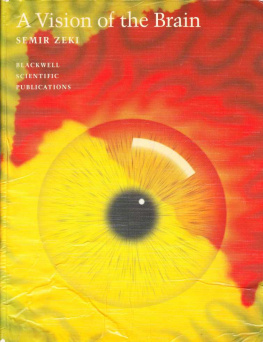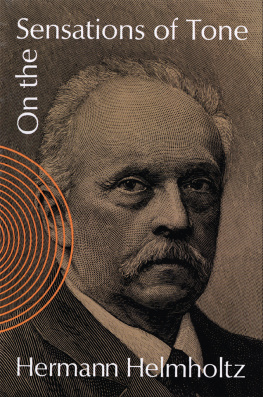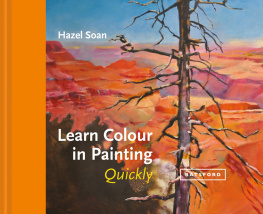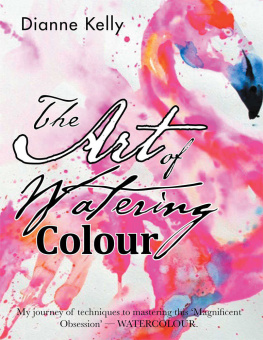.. There is, it seems to us,
At best, only a limited value
In the knowledge derived from experience.
The knowledge imposes a pattern, and falsifies, For the pattern is new in every moment And every moment is a new and shocking Valuation of all we have been.
T.S. Eliot, from The Four Quartets (East Coker)
For Anne-Marie
Contents
Preface, ix
Acknowledgements, xi Prologue, 1
1 The retina and the visual image, 9
2 Functional specialization in human cerebral cortex, 17
3 The representation of the retina in the primary visual cortex, 22
4 Colour in the cerebral cortex, 33
5 The evidence against a colour centre in the cortex, 41
6 The concept of the duality of the visual process, 50
7 The extent of the visual receptive cortex, 57
8 The spell of cortical architecture, 66
9 Hierarchies in the visual system, 73
10 A motion-blind patient, 82
11 The multiple visual areas of the cerebral cortex, 87
12 The basic anatomy of the visual areas, 94
13 Parallelism in the visual cortex, 115
14 Functional specialization in the visual cortex, 122
15 Functional specialization in human visual cortex, 131
16 The collapse of the old concepts, 142
17 The mapping of visual functions in the brain, 147
18 The corpus callosum as a guide to functional specialization in the visual cortex, 165
19 Functional segregation in cortical areas feeding the specialized visual areas, 171
20 The P and M pathways and the 'what and where' doctrine, 186
21 The modularity of the brain, 197
The plasticity of the brain, 207 Colour vision and the brain, 227 The cerebral cortex as a categorizer, 241
The retinex theory and the organization of the colour pathways in the brain, 246
The physiology of the colour pathways, 256
Some specific visual disturbances of cerebral origin, 264
A tense relationship, 288
A theory of multi-stage integration in the visual cortex, 295
The disintegration of cerebral integration, 309
The anatomy of integration, 321
Further unsolved problems of integration, 337
Consciousness and knowledge through vision, 345
Epilogue, 354
Index, 359
Colour plates 1-4, facing page 68; 5-17, facing page 188; 18-23, facing page 308.
Preface
In this book I give a personal view of the brain, based largely on my own work and on other work which seemed to me to be particularly relevant and interesting. I wrote it partly to satisfy my curiosity and partly for the enjoyment of my friends and colleagues and others interested in the subject. If, after reading it, you find that you have learned something about the brain and about vision which you did not know before, then I shall have been rewarded. If reading the book provides you with new insights about brain function, then I shall have been amply rewarded. But my greatest reward will be if the book inspires you to develop new ideas about the brain and design new experiments to test one aspect or another of brain function. The study of the brain is still in its infancy and many exciting ideas about it remain to be generated and to be tested. I hope that no one will be deterred from asking new questions and suggesting new experiments simply because they are not specialists in brain studies. Leaving it to the specialist is about the greatest disservice that one can render to brain science in its present state. The question that the most humble person can ask about the brain is often surprisingly sophisticated and one to which the most accomplished specialist has no answer. Moreover, with the rapid development of new techniques, experiments which would have seemed outrageous even five years ago have moved into the realms of the practical. Perhaps what is needed most in brain studies is the courage to ask questions that may even seem trivial and may therefore inhibit their being asked. I once learned a good lesson from my then five-year-old son who, having seen the selective responses to colour of a single cell in the anaesthetized brain, asked somewhat hesitantly, 'But how does this reach the mind?' It was a child's question but a deeply profound one nevertheless and one to which we still have no answer; no one will understand the workings of the visual cortex or of the brain until they can answer his question. No one should therefore fear that they are making a fool of themselves by asking such questions. You may find that you are making a fool of the specialist, not because he does not have an answer to your question, but because he may not have even realized that there is a question to answer. On the other hand, no one should be disappointed or surprised if an answer turns out to be wrong in the end. The cerebral cortex is a great and complex organ about which we know very little. It has been the graveyard of great and brilliant men and of exciting and new ideas. In studying the cerebral cortex, what is required above all is humility. Even Santiago Ramon Cajal, one of the most brilliant and dogmatic neuroscientists, was subdued with humility when he approached the cerebral cortex. What he wrote in his book Histoloz~ e du Systme Nerveux almost sixty years ago remains true today:
A dire vrai, il n'est pas possible, dans l'etat actuel de nos connaissances, de formuler une thorie definitive du plan...fonctionnel du cerveau....11 est inutile de dire que nous ne prtendons pas donner notre hypothse un caractre dogmatique; nous savons trop bien que des faits imprvus modifient ou renversent, du jour au lendemain, nos conjectures scientifiques. Tout ce que nous pouvons souhaiter, c'est qu'il reste de notre conception quelquesuns des principes sur lesquelles nous l'avons base....*
The reader must not seek to find in this book a detailed coverage of all that is known about the visual cortex. There are many areas, such as the pharmacology of the visual cortex or its development, which have been given scant coverage or none at all. This can be explained partly by the fact that I have written about what has interested me, and partly by the fact that I have tried to write for the more general reader who may want to have an idea of how the visual cortex, and the brain, works without getting lost in too many details. Some details are nevertheless necessary and these are described in a few brief chapters. The more general reader can skip these without losing the main thrust of the argument while the contents of the chapters may be too well known to the specialist, who may therefore also want to skip them. The more serious readers will have to endure them in order to better understand the more exciting part of the story.
I hope that they find themselves adequately rewarded for the minimum of patience necessary to read these brief chapters.
Above all, I hope that all who read the book will begin to understand what great fun the study of the brain can be.
S. Zeki Ton don
* In truth, it is not possible, in our present state of knowledge, to formulate a defmrtive theory of the functional plan of the brain.... It is obvious that we do *-ot wish to give our hypothesis a dogmatic character; we know only too well that unforsecn facts modify and even reverse, from one day to the next, our scientific conjectures. All that we could hope for is that there should, remain of our concept something of the principles on which it is based.
Acknowledgements
I acknowledge with gratitude the help that I have received from many colleagues in preparing this book. I am grateful in particular for the detailed comments made on earlier versions of the manuscript by Bernard Katz, Richard Morris and Eric Kandel. Bernard Katz also translated many of the critical papers in the German literature for me. Without that help, it would not have been possible to write an account of the historical developments which have dominated our views of how the visual cortex functions. It was a collaboration which I much enjoyed. I am also indebted to Stewart Shipp for the many discussions on the relative merits of various arguments and for his comments on some of the chapters, and to Richard Frackowiak and his laboratory for the experiments on the human brain and for the comments he has made on the relevant chapters here.
Next page











